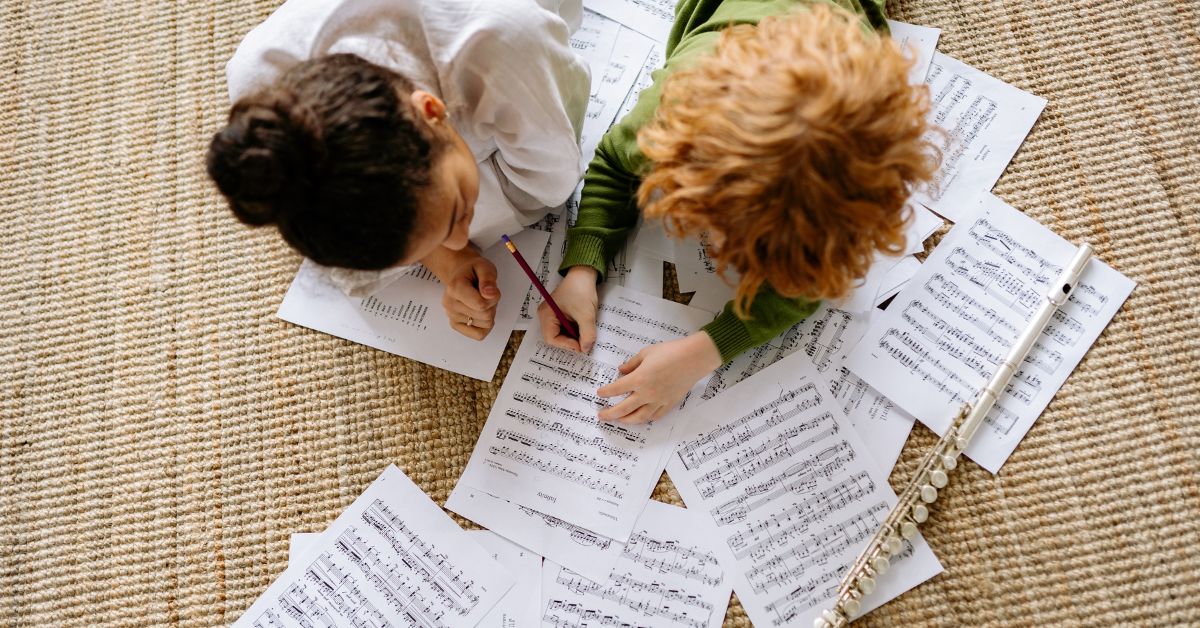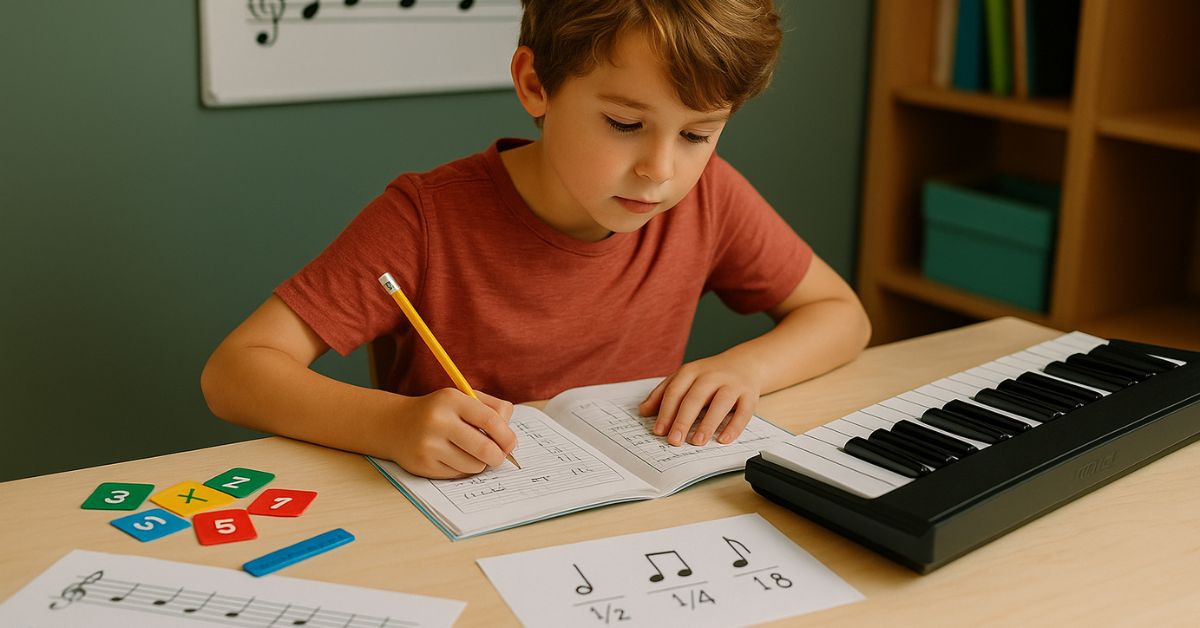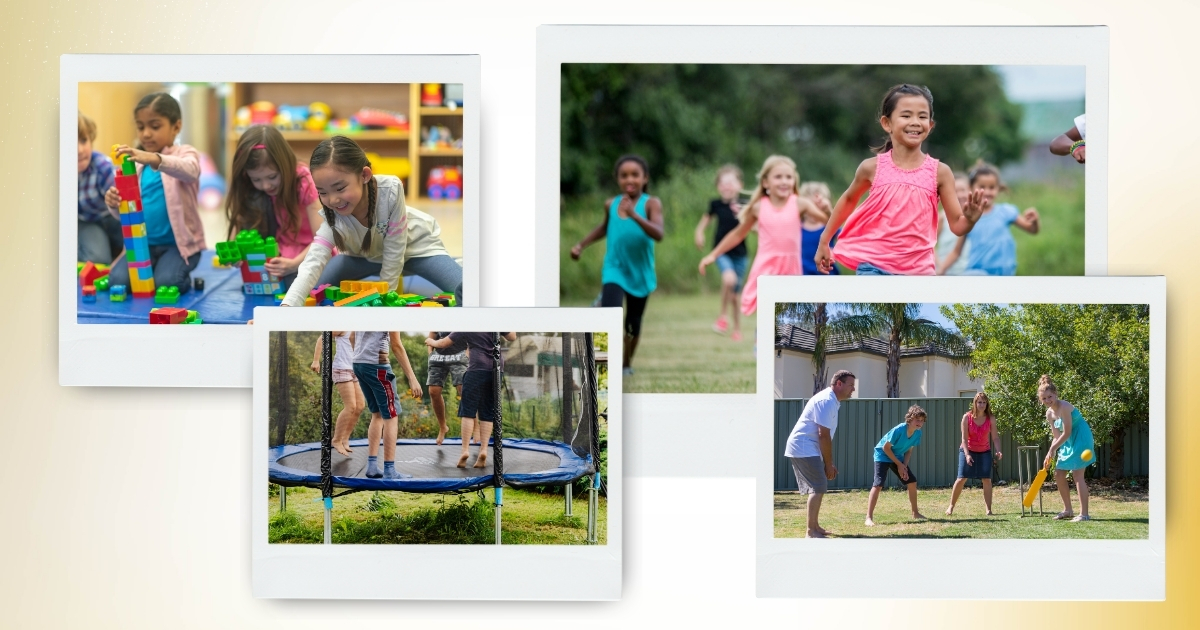Homeschooling offers the flexibility to explore creative teaching methods that make learning engaging and effective. One approach that has gained significant attention is integrating music into mathematics education. Using music to teach math is a dynamic and accessible strategy that connects abstract mathematical concepts to patterns, rhythms, and melodies, making them easier for students to grasp.
Below, you’ll discover how music can deepen understanding, alongside actionable tips for incorporating it into your homeschool routine.
The Connection Between Music And Math
Music and math might seem like two completely different subjects, but they share a deep, inherent connection. Both disciplines are rooted in patterns, structure, and logical reasoning. Exploring this connection can provide valuable insights into how music can enhance mathematical understanding.
Patterns and Sequences
At its core, math is about recognizing patterns and sequences, just like music. For example:
- Rhythms and Beats: Musical rhythms are essentially patterns of sound, similar to number patterns in mathematics. Counting beats in a measure mirrors the process of identifying numerical sequences.
- Musical Scales: Scales in music are ordered sequences of notes, which can be related to mathematical concepts like intervals and ratios.
By identifying patterns in music, children can improve their ability to spot patterns in math, strengthening skills like sequencing, prediction, and organization.
Fractions and Division
Many elements of music naturally involve fractions. For instance:
- Breaking a musical measure into halves, quarters, or eighths aligns with understanding fractions in math.
- Counting beats in time signatures, like 4/4 or 3/4, introduces students to division and how parts make up a whole.
When children explore these concepts through music, the visual and auditory representation can make fractions and division less intimidating.
Spatial-Temporal Reasoning
Playing and listening to music has been shown to improve spatial-temporal reasoning, a key skill in understanding geometry and problem-solving in mathematics. For instance:
- Reading sheet music requires the brain to interpret spatial relationships between notes and translate them into timing and pitches.
- This process is similar to solving geometry problems, where the brain visualizes spatial relationships between shapes and lines.
Memory and Retention
Music has the power to make learning stick. Memorizing mathematical formulas, multiplication tables, or sequences often becomes easier when paired with a melody or rhythm. This is why children learn the ABCs through a song; the same principle can be applied to math.

Math Learning Through Music
Once parents understand the deep connection between math and music, they can use this powerful combination in their homeschool curriculum. Here are some practical ways to integrate music into math lessons.
Counting with Rhythms
Rhythm-based activities are excellent for teaching counting and sequencing. Here’s how:
- Clap and Count: Have your child clap along to a rhythm as they count aloud. For example, you can clap a beat and count up by twos to practice skip counting.
- Percussion Instruments: Use simple instruments like tambourines or drums to represent numbers. For example, play four beats for “4,” and then divide them into two groups of two to demonstrate multiplication or division.
Rhythm-based counting is especially effective for younger children who are still developing foundational math skills.
Learning Multiplication Tables with Songs
Songs are a fantastic way to memorize multiplication tables. There are plenty of multiplication songs available online, but you can also create your own:
- Simple Tunes: Pair multiplication tables with familiar melodies like “Twinkle, Twinkle, Little Star” to make them memorable.
- Rhythmic Repetition: Adding a drumbeat or clapping pattern while reciting multiplication facts can make the process more engaging.
By turning rote memorization of times tables into a musical activity, students are more likely to retain the information long-term.
Exploring Fractions with Music
Fractions can feel abstract, but music makes them tangible and fun. Try these hands-on activities:
- Rhythmic Breakdown: Use a piano or app to demonstrate different note types (e.g., whole, half, quarter notes). Explain how two quarter notes equal one-half note, and so on.
- Fraction Drumming: Write simple rhythms using fractions—for example, one whole note equals four quarter beats. Encourage your child to drum these patterns while saying the corresponding fractions.
These activities make fractions come alive, helping students understand their practical applications.
Incorporating Music Theory into Math Lessons
Music theory offers plenty of opportunities to teach core math concepts. For older children or those interested in playing an instrument, music theory can deepen their understanding of math.
- Frequency and Pitch: Musical notes correspond to specific sound frequencies. Experimenting with these can help students understand concepts like ratios and proportions.
- Intervals and Scales: Discuss how intervals between notes are mathematically related. For example, the relationship between notes in a major scale can be described using simple ratios (2:1, 3:2).
- Music Composition: Composing music introduces concepts like symmetry, balance, and proportionality, all of which are foundational to advanced mathematics.
These approaches allow children to appreciate the overlap between creative and logical thinking, making math feel less abstract and more interconnected with their daily lives.
Benefits of Music-Integrated Math Instruction
When music becomes part of a math lesson plan, students reap multiple rewards. These benefits extend beyond academics and can positively impact their emotional and social development as well.
- Enhanced Engagement: Music captivates attention, making math lessons feel like an enjoyable activity rather than a chore.
- Improved Focus: Listening to or playing music before math sessions can prime the brain for better concentration and clarity.
- Reduced Anxiety: For students who feel intimidated by math, music serves as a stress-reliever, creating a more relaxed learning environment.
- Collaboration Skills: Group activities like singing math songs or performing rhythm exercises encourage teamwork and communication skills.
Integrating music isn’t just about improving math scores; it’s about fostering a love for learning in a well-rounded way.
How To Start Using Music To Teach Math
Getting started with using music to teach math doesn’t require any advanced musical training. Here are some actionable steps to bring this approach into your homeschool routine:
Build a Musical Math Toolkit
Start by gathering simple resources you can use repeatedly:
- Instruments like xylophones, drums, or even household items for percussion activities.
- Musical math videos or apps that offer interactive lessons.
- Songbooks or playlists of educational math songs.
Create Themed Lesson Plans
Design lessons around specific math topics, integrating music into each session. For example:
- Fractions Day: Focus on fractions through rhythm and note values.
- Multiplication Party: Dedicate a session to singing and clapping multiplication tables.
Consistency is key, so incorporate music into your schedule regularly.
Encourage Hands-On Activities
Hands-on experiences reinforce connections between music and math. Encourage activities like:
- Building simple musical instruments to explore vibrations and patterns.
- Singing math-related songs together to create a shared and memorable experience.
- Using free online tools or apps for guided musical math games.
Music as a Long-Term Learning Tool
Using music to teach math isn’t only beneficial in the short term. It instills skills like pattern recognition, memory, and creative thinking that extend across all areas of learning and life. Whether you’re teaching a pre-K learner to count with a rhythm or helping a high schooler explore the relationship between music theory and geometry, music offers an adaptable, meaningful way to approach math education.
When parents incorporate music into their homeschool math routines, they aren’t just teaching numbers and equations; they are cultivating critical thinking, problem-solving, and a lifelong love for learning. Music teaches the beauty of patterns, the value of practice, and the joy of discovery, all of which underpin every mathematical concept your child will encounter.





